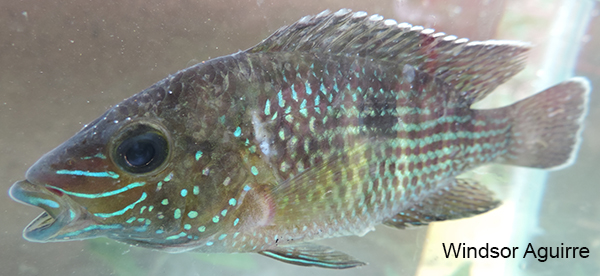| SOURCE FOR OCCURRENCE IN ECUADOR: Wijkmark et al. (2012), Jimenez et al. (2015). |
| ORIGINAL DESCRIPTION: Wijkmark, N., S.O. Kullander, and R.E. Barriga Salazar. 2012. Andinoacara blombergi, a new species
from the rio Esmeraldas basin in Ecuador and a review of A. rivulatus (Teleostei: Cichlidae). Ichthyological Explorations of Freshwaters 23(2):117-137. |
| TYPE SPECIMENS: Holotype: MEPN 11180 (Museo de la Escuela Politecnica Nacional, Ecuador). |
| TAXONOMIC STATUS: Questionable. This is a recently described species considered valid by Eschmeyer and Fricke (2016), however, Musilova et al. (2015) failed to find significant genetic divergence between it and A. rivulatus based on an analysis of mitochondrial cytochrome b and nuclear S7 intron sequences. If valid, it must be very closely related to A. rivulatus, which occurs southward from the Guayas River drainage. |
| RANGE ECUADOR: This species occurs in the Esmeraldas river drainage and possibly Santiago-Cayapas drainage (Wijkmark et al., 2012). |
| RANGE OUTSIDE OF ECUADOR: None. |
| COLLECTIONS IN ECUADOR: |
| MAXIMUM SIZE: About 10.5 cm standard length (Wijkmark et al., 2012). |
| DISTINGUISHING FEATURES: Andinoacara blombergi is a recently described species from the Esmeraldas River drainage in northwestern Ecuador that is very closely related to A. rivulatus from southwestern Ecuador. According to Wijkmark et al. (2012), A. blombergi can be distinguished from A. rivulatus by an E1 scale count of 25, exceptionally 24 or 26 (vs. 24, exceptionally 23, in A. rivulatus), narrower head (15.2-17.8 vs. 17.7-22.0% of SL in A. rivulatus), and narrower interorbital space (8.9-10.9 vs. 9.9-15.5% SL in A. rivulatus). Based on Wijmark et al. (2012), Andionacara in the Esmeraldas drainage are considered A. blombergi, while Andinoacara in the Guayas and other southern rivers are considered A. rivulatus. |
| ECOLOGY: Species in the genus Andinoacara are known as "viejas" in Ecuador. Although specific ecological data on A. blombergi are not available, species in the genus tend to be common and ecologically important in the streams that they inhabit, where they feed on small invertebrates and fishes. |
| ECONOMIC IMPORTANCE: NA. |
| CONSERVATION STATUS: NA. |
| LINK TO FISHBASE PAGE: Click here for link |
| SPECIES PROFILE CREATED BY: Windsor Aguirre |
| SPECIES PROFILE CONTRIBUTORS: NA |
